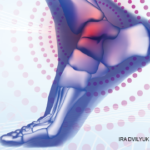There are many options for a rheumatologist to consider when diagnosing & treating a patient with unilateral hip or knee OA. Considering the potential for a discrepancy in leg length & how (& whether) to treat it may be part of
that process.
“I think it is under-appreciated how much the foot may contribute to functional limb-length discrepancies, and the resultant pain and potential arthritic changes that can be associated with this,” Dr. Lane says. “Properly made custom orthotics can play a pivotal role to dramatically reduce or eliminate pain, progression of deformity and joint damage in this situation.”
There may also be reason not to go straight to treating LLD because it can have unintended consequences. For example, prescribing a prosthetic such as a lift or an insert may lead the patient to feel “disabled” or like they can never walk without their shoes on, Dr. Smith says. Instead, physical activity and exercise can be effective ways to treat OA pain and help the patient return to more normal function.10
Recent onset of unilateral knee pain is clinically important, too, and is best treated conservatively to start, Dr. Smith says. “Even if it seems like it’s bone on bone, if it’s only recently painful, you can definitely treat it conservatively, especially if you can normalize the quad. So if you have atrophy of the quadriceps muscle, you get the quad back. If you have joint effusion, you can reduce joint effusion. And if you have significant motion loss, if you can normalize motion and get back to normal gait, actually the prognosis is excellent.”
There are many options for a rheumatologist to consider when diagnosing and treating a patient with unilateral hip or knee OA. Considering the potential for a discrepancy in leg length and how (and whether) to treat it may be part of that process. The good news is that with the proper diagnosis and treatment regimen, which may include working with other healthcare providers, the patient can overcome their pain and get back to living their life.
Abdollah Shams-Pirzadeh, MD, PA, FACR, is a practicing rheumatologist at the AOP Center (Arthritis, Osteoporosis and Pain Management Center), Baltimore.
Kimberly Retzlaff is a freelance medical journalist based in Denver.
References
- Murray KJ, Azari MF. Leg length discrepancy and osteoarthritis in the knee, hip and lumbar spine. J Can Chiropr Assoc. 2015 Sep;59(3):226–237.
- Golightly YM, Allen KD, Helmick CG, Renner JB, Jordan JM. Symptoms of the knee and hip in individuals with and without limb length inequality. Osteoarthr Cartilage. 2009 May;17(5):596–600.
- Harvey WF, Yang M, Cooke TDV, et al. Association of leg-length inequality with knee osteoarthritis: A cohort study. Ann Intern Med. 2010 Mar;152(5):287–295.
- Brady RJ, Dean JB, Skinner TM, Gross MT. Limb length inequality: Clinical implications for assessment and intervention. J Orthop Sports Phys Ther. 2003 May;33(5):221–234.
- Felson DT, Niu J, Gross KD, et al. Valgus malalignment is a risk factor for lateral knee osteoarthritis incidence and progression: Findings from the Multicenter Osteoarthritis Study and the Osteoarthritis Initiative. Arthritis Rheum. 2013 Feb;65(2):355–362.
- Lane G. A novel technique to determine foot contribution to limb-length discrepancy. J Am Podiatr Med Assoc. 2017 Jul;107(4):340–341.
- Krettek C, Koch T, Henzler D, Blauth M, Hoffmann R. [A new procedure for determining leg length and leg length inequality using ultrasound. II: Comparison of ultrasound, teleradiography and 2 clinical procedures in 50 patients.] [Article in German] Unfallchirurg. 1996 Jan;99(1):43–51.
- Rannisto S, Paalanne N, Rannisto PH, Haapanen A, Oksaoja S, Uitti J, et al. Measurement of leg-length discrepancy using laser-based ultrasound method. Acta Radiologica. 2011;52(10):1143–1146.
- Guggenberger R, Pfirrmann CWA, Koch PP, Buck FM. Assessment of lower limb length and alignment by biplanar linear radiography: Comparison with supine CT and upright full-length radiography. AJR Am J Roentgenol. 2014 Feb;202(2):W161–W167.
- Gay C, Chabaud A, Guilley E, Coudeyre E. Educating patients about the benefits of physical activity and exercise for their hip and knee osteoarthritis. Systematic literature review. Ann Phys Rehabil Med. 2016 Jun;59(3):174–183.

